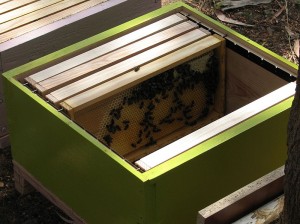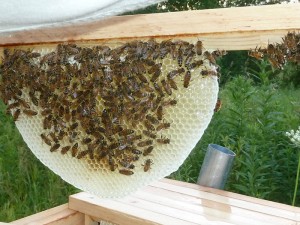
Bees are one of nature’s most amazing and complex insects, and one of the more useful for humans, flora, and fauna. Pollination of plants and flowers is crucial in farms and agriculture, as well as for wildlife.
Beekeeping is especially useful now due to the increasing rate of bee colony collapse disorder around the world over the past decade.This has many looking into supporting bees by keeping them on their properties. They can be kept on both large rural properties, as well as small urban environments.
A word of warning. Just like getting into beer brewing as a hobby opens your mind to the world of hops, yeast, fermentation and appreciation of a quality product; beekeeping pushes you to respect and pay attention to the natural world. Beekeepers know which flowers bloom first, are attentive to rain, and pay attention to humidity, all of which affect their bees and the honey produced. Some keepers are bee-centric, and just love bees; most though are honey-centric and enjoy the gift that bees provide.
Beekeeping 101: Hives
Bees are kept in hives designed to keep the colony safe, and produce honey in the beeswax honeycomb they make.
Most beekeepers still use a hive that was first designed in the early 1850s, which has been improved to a popular type called a Langstroth. It is designed to help beekeepers place individual frames inside a box called a super. Bees build a honeycomb inside the frame, which can be empty or have some foundation attached to assist the bees make a comb faster. A hive can have a number of supers with frames, which are easily swapped in or out which is useful for for hive maintenance, observation, and for honey extraction.
Don’t think of the natural comb as just a container for your breakfast spread; the comb serves as the tissue and structure of the hive, and much more. The wax is made from the bees' abdomens, and holds a history and memory via the chemical signals put into it by the bees. The cells are made from over 300 different chemical components, and the wax removes toxins from honey.
Beekeeping 102: Caring for bees

A beehive stores honey made from nectar both for the present, and for the future. Bees are drones, or workers, and most of the time when conditions are favorable, they make far far honey than what they need. That provides opportunity for keepers to remove excess honey that the colony can spare if they are lucky.
Of course, removing honey from bees doesn’t please the bees, which can mean stinging of honey-thieves, including beekeepers, and most keepers are stung at least a few times during harvesting.
Safety gear to reduce stings includes a classic white outfit with long sleeves, hat with face mesh, as well as techniques to calm bees. Some techniques include using smoke to mask bee alarm pheromones, and choosing early mornings when bees are less active.
Bees can fly as far as two or three miles (up to nearly five kilometers) to find flowers to gather nectar from. That means you don’t have to own a flowering garden to support a hive.
Keepers need to be careful in that bees need honey for food and energy. In the winter or in bad droughts, there are only a few flowering plants, so bees survive off the honey they’ve stored. Robbing the hives of too much honey can cause colony collapse, which means beekeepers need to be mindful of not hurting their hives. Emergency food in the form of sugar water can be a lifesaver for colonies in drought or before winter, or can be used enhance the performance of a colony.
Beekeeping 103: Starting Out
Starting out keeping bees involves buying a hive, and bees. New beekeepers can take classes, learn from mentors and of course, read articles and books to understand what they need to do to sustain a colony.
The first year of beekeeping is generally a building year for bees, who require around eight pounds of nectar to produce one pound of wax, which is required to be made into a comb to store honey. Some first year hives do produce honey depending on the conditions. A producing hive with an established colony and comb can produce between 60-200 pounds of honey a year depending on the health of the hive, surrounding flora and fauna, and climate. Warmer climates are easier for bees to survive.

Deciding how much honey bees need to survive, and how much you can take from a hive is not a straightforward decision. The truth is, you can’t predict exactly how much honey a colony will need, as that's essentially crystal-ball gazing for the winter and spring ahead.
Taking a fair amount of honey will depend on many factors. Typically, an inspection of the hive reveals how much honey is available for harvesting, and how much can be left for the hive. In all cases, leaving a little more honey in the box doesn't hurt!
In the US, there's a general agreement that a standard hive should be left with 80 to 90 pounds of honey in all but the warmest areas. That allows for good supply of natural fuel for your hive, and saves on hassles with sugar water. Before taking honey, all the frames in a hive should be checked to assess which frames are for honey, and which frames are for the developing colony, called brood frames. Brood frames are usually in the center.
New hive types have been recently released. The Australian-made Flow Hive is one of the hottest. Flow Hives don’t disturb colonies, reduce the hassles with robbing hives, and provides honey on tap.
Initial reviews of the product have been positive, but some point out concerns that people may believe that the Flow Hive makes keeping bees look extremely easy - get bees, wait a few months, and just turn the tap when you want honey! The truth is beekeeping requires upkeep, patience, and understanding of the world of bees, but the magic of the Flow Hive has attracted many new faces to the world of beekeeping, exploring what are ingenious insects.



